Dénia Lara • Education, The Metropolitan Museum of Art
Recommended citation: Dénia Lara, “The Grave of the Rose: Seeing Charlotte Canda through Her Brooklyn Tomb,” Different Visions: New Perspectives on Medieval Art 8 (2022). https://doi.org/10.61302/MIXF4703.
Two white marble pinnacles arose against the sky as I followed the meandering paths of The Green-Wood Cemetery on a clear autumn day. As I approached, the central structure of this monument came into my view: a single arched canopy embellished with the visual language of the Gothic Revival. From within this shadowy niche, the draped robes of a figure peeked through. Before I could decipher the bold blackletter inscription carved into the stone platform, I was pleased to realize that I’d arrived at a site where many have pilgrimaged to do what I’d also come to do: look with pathos at the lovely face of a girl made famous by death.
Here’s the legend. On her 17th birthday, February 3rd, 1845, Miss Charlotte Canda spent the day at her Manhattan home, quietly celebrating the occasion with her family. The charming young debutante was the adopted daughter of Charles Canda, a French national and former officer in Napoleon’s army, and his wife, Adele. The Candas ran a school for girls where Mr. Canda taught drawing, and the couple raised Charlotte in a cultivated environment with the highest advantages in education a young woman of the era could find. She spoke six languages with ease, practiced multiple musical instruments, and shared her father’s talent for artistic composition. In the evening, Charlotte answered an invite from a small group of close friends, who wished for her to join them in festivities, presumably in her honor. With her father as chaperone, she headed to the party on a hired carriage.
At the end of this merry evening, Miss Canda and Mr. Canda rode home, this time accompanied by one of Charlotte’s friends, whom they had agreed to drop off at her house on Waverly Street. The winter weather turned stormy as the horses trotted through the dark city streets. When they reached the young lady’s house, Mr. Canda escorted Charlotte’s friend to her front door, leaving his daughter comfortably seated in the carriage. The driver stood beside the cab’s door, which he had opened for the passengers to exit, and was now awaiting Mr. Canda’s return. It was in this instance that the horses, likely spooked by the inclement weather, bolted towards Broadway, open-door carriage in tow. By the time the driver caught up with the horses, the cab was empty. Charlotte was soon found unconscious in the middle of a snowy street; her head had struck the pavement when she was thrown from the carriage. Though aid arrived quickly, within the hour Charlotte Canda’s life came to an end. Her heartbroken father held her in his arms until her last breath.[1]
Devastated by the loss of their only child, the Candas held a grand Catholic funeral mass for Charlotte and temporarily interred her remains at Old St. Patrick’s Cathedral while they planned a more permanent memorial for their daughter. Among Charlotte’s belongings they found a portfolio containing her many drawings, including one that drew immediate interest, as it sadly prophesied the girl’s fate. The previous year, Charlotte’s beloved aunt Clemence had passed away from illness. In her grief, Charlotte sketched plans for an elaborate memorial to accompany Clemence’s grave and stashed it away in her papers. With these drawings in hand, Charles commissioned famed sculptors John Frazee and Robert Launitz to execute a funerary monument which was “in its general outline and essential features” conceived by the late Charlotte herself.[2]
Mr. Canda spared no expense for this new mausoleum [Fig. 1], situated beside one of the main avenues of Brooklyn’s Green-Wood Cemetery.
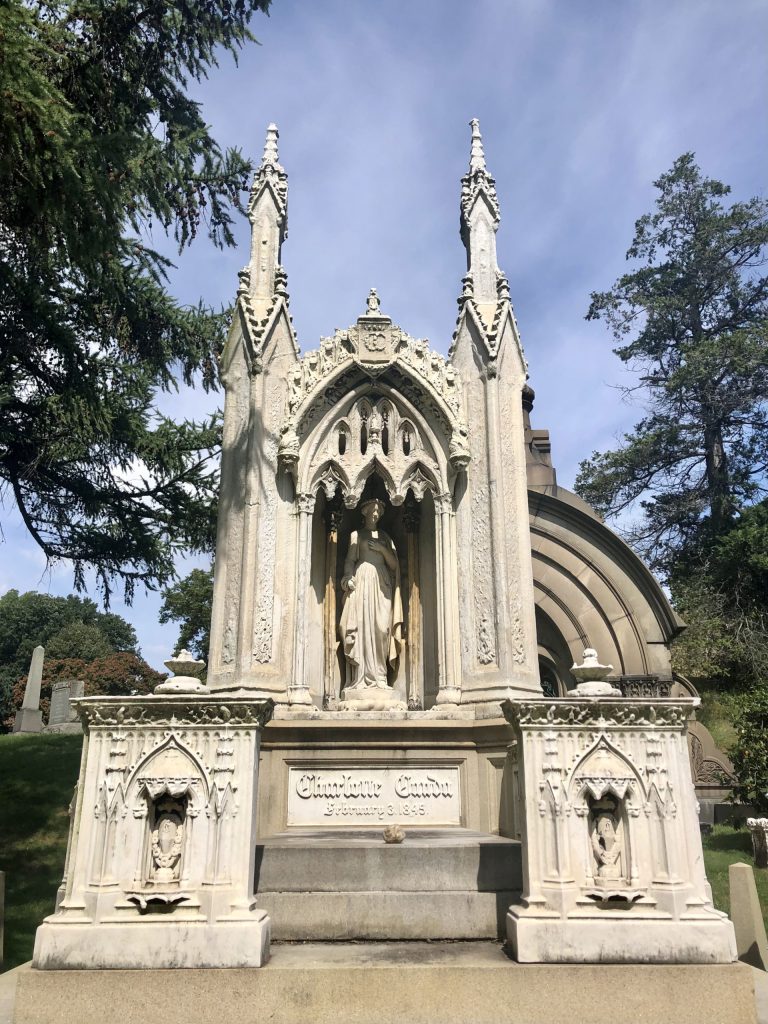
Fig. 1. Front view of Charlotte Canda’s tomb monument from ground level. Green-Wood Cemetery, Brooklyn NY. Photo: author.
Made of white Carrara marble, the tabernacle-style monument sits on an octogonal platform with ascending steps. A balustrade surrounds the large ledger stone that marks the actual tomb. The cost was inconclusively reported by separate sources at a total between 10,000 and 45,000 dollars, an extraordinary sum for the time, even at its lowest estimate.[3] Charles advised the sculptors in producing a figure to serve as the center-piece of the work as well as a program of ornament teeming with symbolism. The Neo-Gothic spires reach a height of seventeen feet, Charlotte’s age at the time of her death, and her effigy wears a crown of seventeen roses. Within the niche, shining stars symbolize her immortal soul, while the exterior shell of the structure depicts inverted torches, a common motif of the funerary arts, representing a life extinguished. Winged angels kneel on either side of the tomb, removed by several feet from its base.
Just beyond the boundaries of the Canda memorial lies the tragic coda to an already tragic story. Charles-Albert Jarrett de la Marie, a young Frenchman from a minor noble family, was engaged to be married to Charlotte Canda. After Charlotte’s death, the circumstances of his life descended into chaos. A year later, while visiting the Candas in New York, he took his own life at the Hotel de Paris.[4] As a Catholic who had committed suicide, Charles-Albert could not be buried on consecrated grounds, but Mr. Canda arranged to have him interred as close as was permissible to his bride-to-be. He rests in the adjacent plot, marked by a simple, elegant headstone bearing his coat of arms [Fig. 2].
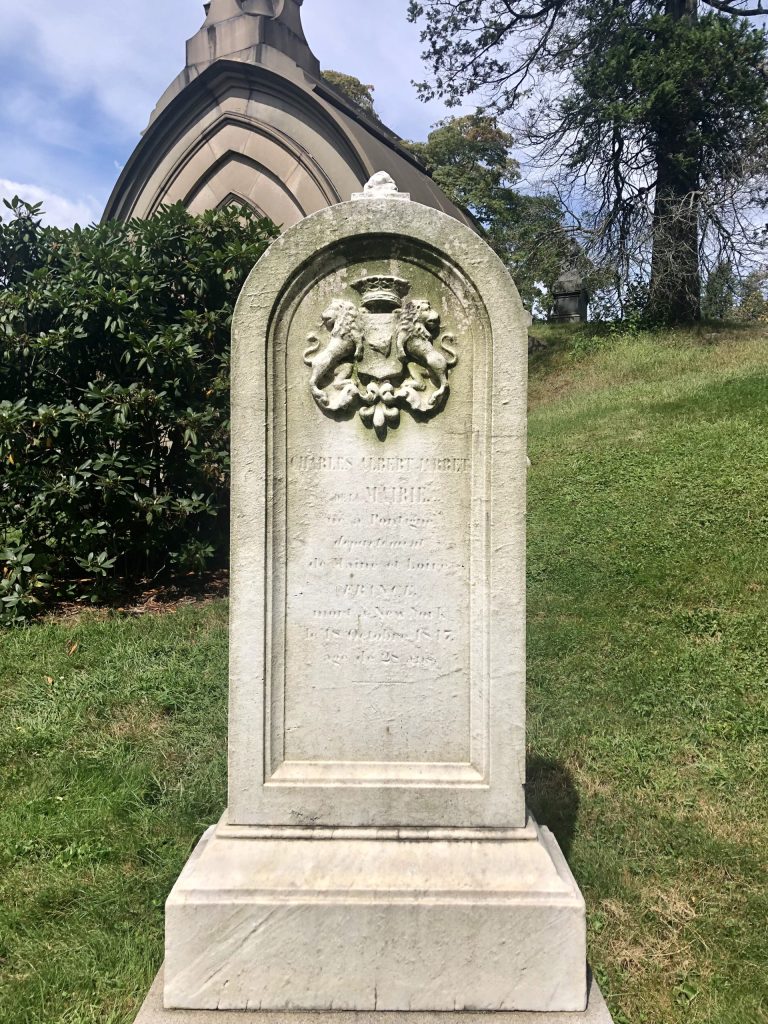
Fig. 2. Headstone marking the grave of Charles-Albert Jarrett de la Marie. Green-Wood Cemetery, Brooklyn, NY. Photo: author.
In the years that followed, visitors to Brooklyn would make Charlotte Canda’s gravesite[5] an item on their itinerary, roused by the memorable melodrama of the girl who designed her own grave. This was a time prior to the completion of Central Park, when the rolling hills of the Green-Wood were dotted with as many picnic blankets as tombstones. Tourists to New York marked the cemetery as a must-see destination, ideal for enjoying a family outing and for viewing sculpted monuments by some of the finest artisans of the period. They came to see Charlotte’s tomb for many reasons, I assume: to admire the hand-crafted beauty of the carving, to marvel at the opulence of the imported marble, and to participate in the theater of grief so ingrained into many aspects of Victorian culture. Charlotte’s death was for a moment fodder for sensationalist press, reported by the papers as an incident of great sorrow, with a likable, innocent young woman at its center.[6] Charles-Albert’s suicide returned the story to the public consciousness a year later and added a subplot of romantic mutual doom, retroactively painting the pair as Romeo and Juliet types. As the story traveled and the legend expanded, the magnificent tomb acted as an ideal site where one could externalize one’s feelings on the situation and experience a sense of fulfillment similar to seeing a celebrity in person. “All tombs around are in its splendor lost,” the poet Daniel Pelton would write of the Canda monument decades later in his collection of poems inspired by the Green-Wood.[7]
The allure of tragic young women is enduring, whether these are real-life celebrities, urban legends, or fantasy characters. Since its Romantic origins in the eighteenth century, medievalism has been an ideal vehicle for concocting this type of image: the damsel meeting death. The era that brought us the Canda mausoleum also brought John Everett Millais’s Ophelia and many visualizations of Lord Tennyson’s Lady of Shalott. The women in these images find themselves in a cataclysmic moment, either close to death or soon thereafter, evoking the illusive transitory state between the known world and what lies beyond. Their long hair and billowing gowns have become trademarks of women who are both beautiful and haunted. Contemporary accounts of Charlotte’s untimely passing make much of her youth, brilliance, charisma, and goodness, building a narrative akin to a literary character, the literature in this case being the story penned by the press and echoed by later writers as they recounted the sentimental details.
I was captivated by Charlotte’s story as soon as I read it, finding myself falling into the soap opera of demise, and in the process discovering that I’m not immune to morbid romanticization. Through a near mythic tale crafted without her participation, Charlotte Canda, once a living person of substance and complexity, was transformed into a virgin sacrifice, the kind seen in every generation since, to appease a public enthralled by threats to feminine innocence. Those who came to see her grave through the years would often refer to Charlotte not by name, but as “the French girl”, a nickname said to have been given to her by the Canda’s household staff.[8] This moniker of dubious origin further separates the person from the persona; “the French girl” is a most shallow description of Charlotte Canda, but it does call to mind the ambiguous intrigue of artistic naming conventions – this could potentially be the name of a painting or a novel.
The immaculate appearance of the sculpted figure meant to represent Charlotte, the focal point of the monument, upholds the archetype put forth by her legend. From within her gabled canopy she stands on a cloud, looking into the distance with a hand over her heart. Waves of hair are neatly pulled back to frame her soft, serene face. I’m told by the 19th-century Green-Wood directories written by Nehemiah Cleaveland that the effigy was sculpted in Charlotte’s likeness, but so far I’ve found no way of confirming this as fact. There is also a claim that the dress seen on the statue is a replica of the birthday gown worn by Charlotte on that fateful day, and yet the squared neckline, flowing drapery, and unstructured bodice does not reflect the fashions of the 1840s. Indeed, the dress form seems historical in a way that is difficult to pinpoint; an intentional anachronism. Taking into consideration that her father was a professional artist, it’s plausible that portraits of Charlotte were made available to Launitz and Frazee as they carried out their work. Still, without a living model to work from, and with no evidence of a death mask cast, the figure’s facial features and ensemble may have been adapted from an existing type with Charles Canda’s help. The final product [Fig. 3] gives the impression of a sculpted saint, in line with late medieval models that have become canon in the Catholic arts: Female Saint Holding a Book, Mary on the Half Shell. It seems to be a conscious choice to immortalize Miss Canda as a near-divine being, eternally virtuous, unbound by temporality.
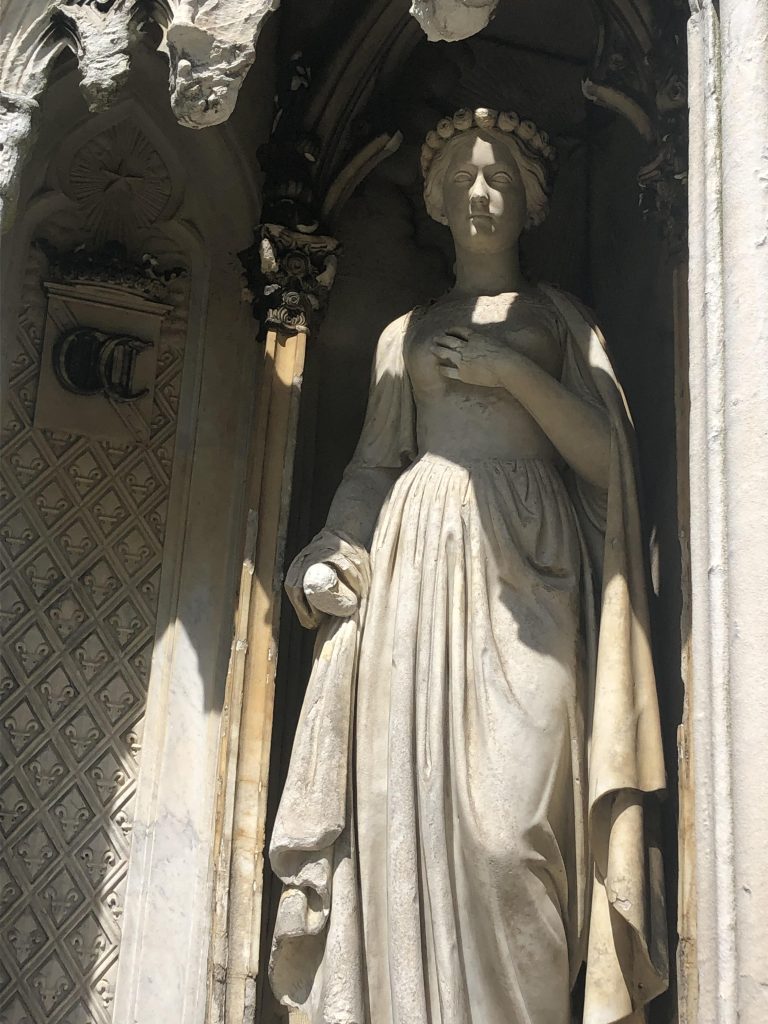
Fig. 3. Detail of the central figure of Charlotte Canda’s tomb monument, viewed from ground level. Green-Wood Cemetery, Brooklyn, NY. Photo: author.
The iconographical work of the sculpture program continues in the abundant symbolism executed from drawings made by Charlotte’s father. In addition to popular funerary motifs, Charles imbued his daughter’s tomb with identity signifiers: a “C.C.” monogram, a fleur-de-lys pattern indicating French heritage, and the recurring seventeen count. Above all, the added ornaments take the form of flowers, leaves, and vines, amounting to a splendid bouquet permanently present at the tomb of the departed. Although these are botanically correct renderings, the arrangements of florals and foliage are at times convoluted, making it difficult to distinguish one from the other, or from the ornamental tracery [Fig. 4].
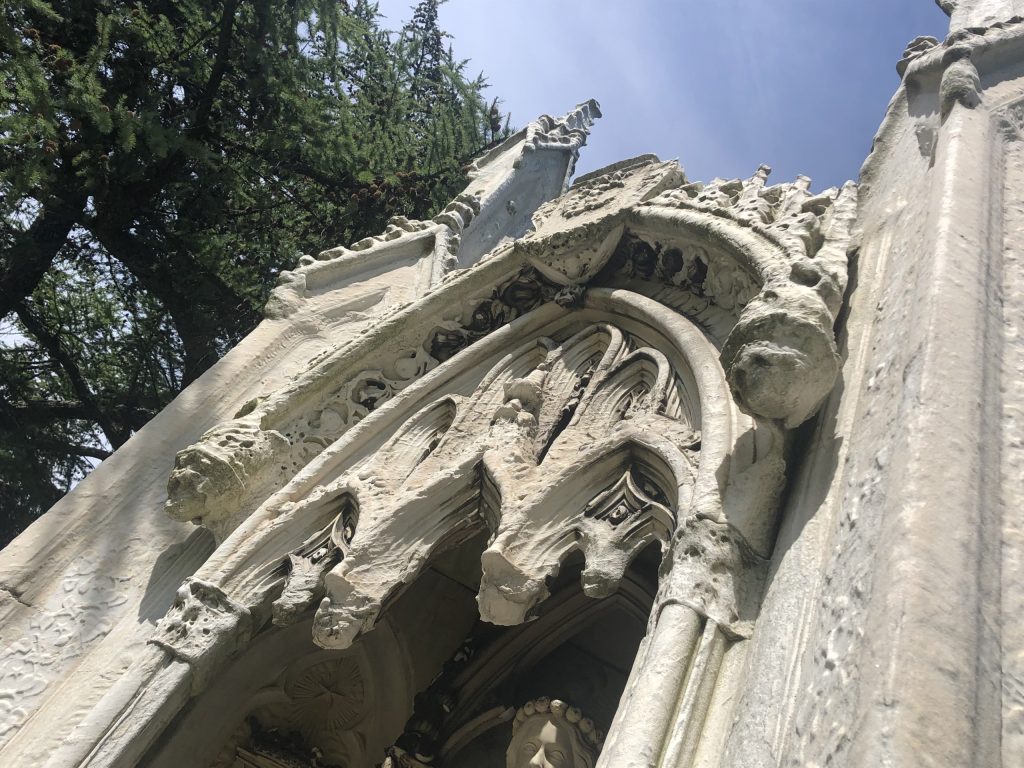
Fig. 4. Detail of the tracery and archivolt. Photo: author.
Truth be told, it took me three visits to the Canda grave, and a close reading of Cleaveland and Smillie’s Green-wood Illustrated, to uncover the most personal symbol: small birds with open wings perched among the branches that adorn the frieze of the balustrade [Fig. 5].
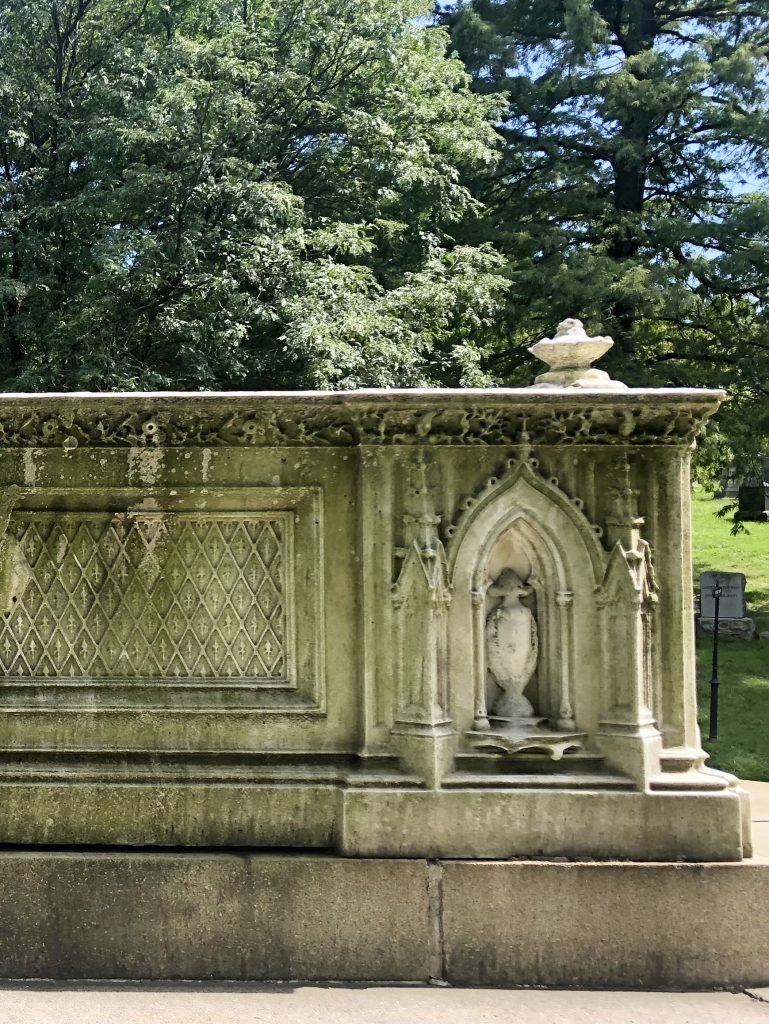
Fig. 5. Detail of the balustrade, including two birds perched on pinnacles. Photo: author.
These are intended to be representations of the parrots Charlotte kept as pets, a heartwarming detail in what is otherwise a shrine to unresolved grief.[9]
The exhaustive descriptions of Charlotte’s tomb in early publications belie the reality that the monument seen by early visitors to the gravesite is not the same we see today. After nearly two centuries of constant exposure to the elements, the detailed carvings of the marble have lost their sharpness, the smaller forms at times bordering on indecipherability. In the brightness of noon, the monument looked to me like a frosted wedding cake slowly melting in the sun. To study the sculpted features of Charlotte’s grave in its worn state is not dissimilar to examining a medieval monument; it’s an exercise in identifying discrete forms blurred by the hand of time. Green lichens and gray soot are embedded onto the cool, off-white stone. The tablet once inscribed with Charlotte’s cause of death and a poem in tribute to her memory is completely illegible [Fig. 6].

Fig. 6. View of the tomb with the inscription tablet in the foreground. Photo: author.
Despite the significant superficial deterioration, roses remain the most prominent symbol seen in Charlotte’s tomb. In the time I’ve spent at the grave, I’ve spotted roses not only in the garland atop the figure’s head, but in nearly every trimming that adorns the stone. Organized into neat rows, they populate the otherwise plain areas of the marble slab, and clusters of roses appear in the capitals of the slender colonettes that support the canopy’s ribbed vaulting. Although these are no longer visible due to erosion, roses originally decorated the angles of the pinnacles reaching to the very tops of the spires. The immediate impact of the motif was not lost on Daniel Pelton who included the line, “In vain the roses round her bloom” in his ode to Charlotte’s grave. The lines of verse once inscribed on the timeworn tablet also made explicit the connection between sign and person: “So fades — so falls — the opening rose.”[10] The roses carved onto the stone do in fact mainly appear as half-open, permanently suspended in their potential, as Charlotte is. The rose was chosen for her as a personal emblem, as a symbol befitting of a girl-saint. During one of my visits, I noticed a pink plastic rose by Charlotte’s feet, left behind by a fellow admirer.
The Canda monument was, at the time of its construction, at the forefront of the medieval revival trend in the funerary arts in the United States. It predates both the Cemetery’s iconic main gate entrance and the Pierrepont Family Memorial, each designed in Gothic Revival style by the highly influential architect Richard Upjohn. For this new commission, Launitz and Frazee fully embraced the design principles already in practice among contemporary artistic circles in Britain to recapture the spirituality of an earlier age. As the popularity of the style grew in America, Charlotte soon came to stand alongside many other Gothic quotations found in the tombs of the Green-Wood. The Canda monument is overshadowed in scale by the adjacent Dewey family mausoleum [Fig. 7], which stands tall and broad in a single, massive pointed arch.

Fig. 7. View including the Dewey Mausoleum (right). Photo: author.
The grandest building in the cemetery, Warren and Wetmore’s early-20th-century chapel, is also a product of American taste for late medieval style.
Charlotte Canda’s tomb may not have been alone in its archaic splendor for very long, but if it can lay claim to being unique in any aspect, it’s that it was designed, at least in part, by a woman artist. Beyond the tragedy, the most compelling element in the making of this monument is the report that it was modeled directly from one of Charlotte’s sketches. If it’s widely accepted that the main parts of the design were done by Charlotte, then we must acknowledge that in her we find someone who was informed and up-to-date on the growing interest in the tenets of Gothic style.
But the plans, originally intended for her aunt Clemence’s tomb, were not the only noteworthy sketches discovered in Charlotte’s portfolio. Cleaveland also makes mention of a curious historical scene: “ an attempt to depict Cromwell in the act of looking into the coffin of King Charles… A few days later, she drew the scene again in more detail and wrote beneath it in French, Death! I must learn to look thee in the face!”[11] The sketch is traditionally singled out for presenting another foretelling of Charlotte’s death, and indeed there is an eerie quality to its direct reference to confronting one’s mortality. Still, when I read this passage, I couldn’t help but recognize a kindred spirit, a person with keen interest in the distant past. The focus on the theme of death in this drawing is only pertinent because Charlotte died by accident soon after completing it, when in my opinion, the key point of interest should be the artist’s knowledge of history and her imaginative interpretation of this event. A young woman who took pencil to paper to depict the existential thoughts of Oliver Cromwell surely had the heart of an enthusiast.
Feeling a renewed kinship with Charlotte, I made another pilgrimage to her grave. Looking closely at the figure at its center once again, I began to wonder whether I could read more accuracy into it. Her father may have chosen to add visual attributes that portrayed her as saintly, but is it possible that Charlotte did in fact dress in this way? Or perhaps had a quasi-historical gown made especially for her birthday? Some decades later the Artistic Dress movement would take shape among more aesthetically conscious crowds in Britain and America, rejecting ridgid Victorian clothing and favoring the simpler silhouettes and organic materials of bygone eras. As a young creative and intellectual, was Charlotte involved in an early wave of intentional, every-day medievalism? Something like a counterculture? This isn’t really hopeful speculation on my part, rather I wish to not underestimate the will and agency of adolescents to purposely go against the grain and shape their own image as they see fit, especially when paired with a deeply held personal interest.
Taking in the memorial in its entirety again, I felt overcome with a sense of pity, although this time not for the loss of a life, as would have been appropriate. What a shame, I thought, that Charlotte did not live to see this work of hers realized. Her design for Clemence’s tomb was presumably done with great care and emotion, but it was not to come into existence in her lifetime. Then again, I thought, is this the memorial Charlotte actually planned? Was the work executed faithfully? She drafted this monument as a tribute for her aunt, an adult who unromantically died of illness, and yet apparently composed a very idyllic image, noticeably lacking in sobriety. The standing figure is so radiant and idealized, it leads me to wonder whether it was meant to represent the deceased at all. Although commemorative statuary was common in the era during which Charlotte lived, tomb effigies were not. The grave is historicized merely by containing a model of the individual, and furthermore by an attempt at portraiture that does not prioritize the person’s actual appearance. It brings to mind medieval recumbent effigies, wherein “identity resides in markers of gender, status, and lineage,” and individuality is not reliant on physiognomy, as Rachel Dressler expounds in her studies on English alabaster tomb sculpture.[12] The figure is successful in performing graceful femininity, in giving the impression of refinement and culture, and in signaling good breeding via European heritage. Convincingly portraying physical likeness through idiosyncratic features would have not only been unnecessary, but counter to the desired effect.
It’s clear to me that there was much lost between Charlotte’s concept for the design and the visual choices ultimately made by Charles Canda under entirely different circumstances. In sketching out a tomb for Clemence, Charlotte may have intended for the statue to be allegorical, perhaps a sybil or a personification of virtue. But once the plans came into her father’s ownership, the figure came to represent Charlotte herself, as her parents wanted her to be remembered. After all, this was not a figurine within a private family chapel, but a monument on display to the public. I’m faced with the reality that although Charlotte is the credited creator, the memorial as it stands is in no way reflective of her self-image, but a strange asynchronous conversation between Charlotte’s perception of her aunt and Mr. Canda’s sentimental memory of his daughter.
Even with ample sources, so much about the Canda monument seems unknowable. I’ve searched in vain for any trace of Charlotte’s drawings; without these there is no way of truly telling what the artist envisioned. In 2018, Green-Wood Cemetery’s manager of collections rediscovered a misfiled fragment of the blueprints as drawn up by Launitz and Frazee, but Charlotte’s original sketches were not formally archived, in my understanding. All that remains of her pencraft is a note scribbled inside a Parisian-made prayer book which was donated to Green-Wood by a member of her family.[13] I’m hesitant to think that the existence of the sketches were merely a narrative device put forth for the sake of myth-making all along; the specificity of their appearance would make this a far-fetched lie, so I abide by the adage that truth is stranger than fiction. Maybe someday I’ll learn more about them.
It’s difficult to separate fact from fiction when a legend has been purposely constructed. Here we have an embellished story illustrated by an embellished artwork, and yet the life these were inspired by was very real. The emotional side of me, that which recognizes the irrepressible creativity of teenagers, simply believes that this is Charlotte’s work. My practical side tells me that if Charles Canda, an artist of some renown, had composed the plans for this enchanting monument entirely on his own, he would have taken credit for it.
Like the roses carved in stone, everything has become a little blurry through the lens of time. The popularity of the story has diminished over the ages; where once this was America’s most famous grave, it’s now an off-beat piece of Brooklyn lore. The monument remains a highlight in guided tours of the Green-Wood Cemetery, but these days there are rarely crowds. On each occasion I’ve visited, Charlotte and I have spent the entirety of that time by ourselves, uninterrupted. I don’t doubt that the current scenario, which allows for quiet contemplation, is more picturesque, more “Gothic”, if you will. Natural deterioration has transformed this marble spectacle into something resembling a garden folly, basking in its historical allusion atop a green hill. I like to believe Charlotte would appreciate this aesthetic effect.
Even with knowledge of how the Canda monument came to be, early visitors to Charlotte’s tomb were drawn in by her posthumous fame and came to join the artificial cult of mourning, not to take in the work of a young artist. The credit that she was given as a creator of this work has routinely been depreciated as a dramatic element. Despite this, time has managed to return the design to Charlotte. With the frills now faded, what remains of the monument today is “its general outline and essential features,” precisely what we are told was her key contribution to the project. The opening roses that decorate her grave speak to someone not quite at a state of maturity, and yet everything I have learned of her gives me an impression of her depth of character, her inventive spirit, her care and respect for an artistic tradition. Though she stands surrounded by garlands and posies, I don’t believe Charlotte Canda, the artist, has ever been properly given her flowers.
Historical Sources
“Melancholy Accident.” Brooklyn Daily Eagle, 5 February 1845.
“Questions Answered.” Brooklyn Daily Eagle, 23 May 1886.
Cleaveland, Nehemiah and James Smillie. Green-Wood Illustrated. New York: R. Martin, 1847.
Cleaveland, Nehemiah. Green-Wood: A Directory for Visitors. New York: Pudney & Russell, 1851.
Green-Wood Cemetery.Charlotte Canda (1828–1845).”November 26, 2010. https://www.green-wood.com/2010/charlotte-canda/.
Milk, Tim. “Local Legends: ‘The French Girl’.” The Local East Village, 1 February 2011. http://localeastvillage.com/2011/02/01/local-legends-the-french-girl/
Miller, James. Miller’s New York as it is; or, Stranger’s guide-book to the cities of New York, Brooklyn, and adjacent places. New York: J. Miller, 1871.
New York Municipal Archives, NY County Coroner’s Inquests, Roll No. 35, Sept-Dec 1847.
Pittsburgh Morning Post, Charlotte Canda, Pennsylvania, 14 February 1845.
References
| ↑1 | This account is compiled and interpreted by me from newspaper reports dated to 1845, Green-Wood cemetery directories, historic tourist guides, and additional sources to create the effect of a single legend. Retellings of the story often omit details, embellish, or contradict one another depending on the dramatic effect desired by the author. This is my version of the story, with its essential parts included, as I understand it. See below, “Historical Sources.” |
|---|---|
| ↑2 | Nehemiah Cleaveland, Green-Wood: A Directory for Visitors (New York: Pudney & Russell, 1851),75-77. |
| ↑3 | Alexandra Kathryn Mosca gives an estimate of the cost “in excess of $20,000” in her monograph, Green-Wood Cemetery (Charleston: Acadia Publishing, 2008), 97. |
| ↑4 | New York Municipal Archives, NY County Coroner’s Inquests, Roll No. 35, Sept-Dec 1847. |
| ↑5 | Linked image is by James Smillie, from Nehemiah Cleaveland and James Smillie, Green-wood Illustrated (New York: R. Martin, 1847). |
| ↑6 | The Pittsburg Morning Post quoted the New York Morning News regarding Charlotte Canda’s funeral: “No event has for a long time occurred which has cast a similar pall of gloom over our community.” The report further describes Canda as “one of the loveliest ornaments of society.” “Charlotte Canda,” Pittsburgh Morning Post, Feb 14, 1845. |
| ↑7 | Daniel Pelton, Greenwood, an elegy: meditations among the tombs (New York: W.L. Allison, 1897), 48. |
| ↑8 | In the May 23, 1886 edition of the Brooklyn Daily Eagle, a reader submitted a question to the editor to inquire where Charlotte Canda, “better known as the French girl” is buried. |
| ↑9 | Cleaveland and Smillie, Green-wood Illustrated, 6. |
| ↑10 | Cleaveland, Green-Wood: A Directory for Visitors, 71. |
| ↑11 | Cleaveland, Green-Wood: A Directory for Visitors, 75. |
| ↑12 | Rachel Dressler, “Identity, Status, and Material: Medieval Alabaster Effigies in England,” Peregrinations: Journal of Medieval Art and Architecture 5.2 (2015): 84. https://digital.kenyon.edu/perejournal/vol5/iss2/5/ |
| ↑13 | Jeff Richman, “They Were Lost But Now They’re Found,” Green-Wood Cemetery, accessed March 12, 2022, https://www.green-wood.com/2018/it-was-lost-but-now-its-found/. |
